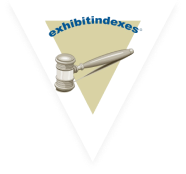14th Jun 2022
The Benefits of Using Exhibit Tabs in Your Legal Practice
Do you feel confident about how to label your exhibits when preparing for trial? Are your supply expenditures optimized to provide essential tools and reduce waste?
Thomson Reuters' 2021 final quarter Peer Monitor Index (PMI) discussed overhead expenses. This reported a 5.8 percent rolling 12-month average rise in law office overhead costs. These figures include office, technology, supply, and marketing expenses.
During the pandemic, many offices sat empty, resulting in lower spending. As firms return to the office, the expense category is rising again. This highlights the need to reexamine your spending practices.
This includes everyday office supplies such as exhibit tabs. Keep reading to see how this seemingly small tool plays a vital role in your practice.
Are Exhibit Tabs a Worthwhile Expenditure?
The Court Statistics Project (CSP) for 2020 examined data from 40 states. They reported that these states had 51,923,466 incoming cases during that year. This doesn't include federal trials.
Every case includes many documents and the submission of evidentiary exhibits. Without stellar organization and filing systems, this can quickly become a logistic nightmare.
Disorganization makes you look unprepared and unprofessional to your client and jury. They lose confidence in what you're telling them.
Adhering to a strict exhibit labeling system generates a positive image. It also meets individual courts’ specific guidelines.
Common Court Requirements for Legal Exhibit Tabs
Ensure that you and your support staff know how your court wants exhibits labeled. Poor preparation can result in inadmissible evidence and put your case at risk.
Separate Evidence into Labeled Categories
First, determine how each piece of evidence will be used during the trial. Categorize your exhibits using legal tabs for easy identification. There are four general types of evidence.
Demonstrative
The type of evidence must fairly and accurately back up the witness’s testimony. It’s important that the witness can verify the exhibit.
Real
Anything tangible, such as a specific object or weapon, is considered real evidence. The item is usually directly relevant to the case, such as a murder weapon.
Documentary
This is another form of real evidence involving documented evidence. One example is a signed and sealed domestic document which is self-authenticating.
Testimonial
The most basic form of evidence is the testimony provided by a competent person. There’s no prerequisite required for its admission.
Use Tabs to Organize Your Exhibits
Decide on a logical order for the introduction of exhibits. For example, you may want to put them in chronological order.
Always organize, tab, bind, or index evidence so you’re not handing over loose papers. Develop a uniform description for all document tabs.
You may wish to use printable exhibit tabs to customize these descriptors. For example, Exhibit 10 – [Tab #].
Label Each Copy of Evidence Made
Most lawyers make at least three copies of every exhibit. One copy is kept by the client’s attorney, and the opposing lawyer receives the second copy. The original is always given to the court when submitting evidence.
The court expects all evidence to be labeled prior to submission. The usual convention is to use alphabetical or numerical exhibit tabs. This provides a clear picture of the order in which evidence was presented.
You may use colored tabs for the copies to ensure you present the correct copy to each party. With printable versions, you can individualize tabs or labels to delineate, for example:
- Defendant exhibit
- Petitioner exhibit
- Plaintiff exhibit
- Respondent exhibit
- State exhibit
You may wish to leave a blank space to enter exhibit numbers/letters and dates during the trial.
Create an Exhibit Index
Most courts want a detailed exhibit index. This lists the date, author or source, and exhibit type. It also includes a brief description to make evidence identification easy.
Different Types of Exhibit Tabs
Legal tabs come in many different styles designed to meet your needs. Some tabs use a “regular” font with upper- and lower-case letters. Others offer numerical tabs printed on both sides to help keep documents in order.
You may choose numbered packs in increments of 25 up to 5,000. You won’t have to worry about running out of numbers which interferes with trial prep.
The laminated exhibit tab pages are 9 by 11 inches to fit with and yet stand out from letter-sized papers. They can withstand frequent “section flipping” and transporting.
The type of binder you use for your documents may impact tab placement. You can choose from side or bottom tabs.
Bottom tab exhibit dividers are great for complex organizational needs. You can use them in combination with single-side tabs.
Some documents include academic papers, legal briefs, proposals, research data, quotes, and more. Bottom tab dividers give you a way to divide the information within your side tabs.
These laminated white dividers resist spills, rips, wear, and tear. The tabs are blank so you can print customized labels or use pre-printed letters or numbers. They’re also slightly larger than standard paper sizes so you can quickly find them.
The bottom tab dividers don’t come punched so you can make them fit your binder. The company will punch them, if you wish, for a small extra fee.
Looking for a Great Source for Legal Supplies?
After reading this article, is your interest in using legal exhibit tabs piqued? Exhibit Indexes is your source for legal supplies at a lower cost than box stores. We stock legal tabs, stock certificates, number dividers, exhibit labels, will supplies, exhibit tabs, and blank tabs.
Unlike other supply stores, we directly pack and ship most of our orders. We only display products that we have in stock. While, on occasion, we may run out of an item, we’ll keep you in the loop and send it quickly.
Shop our products today and get a quick quote and free shipping.




